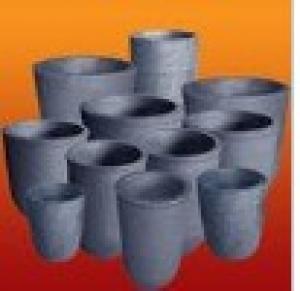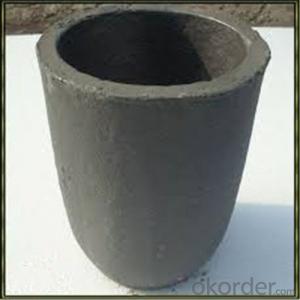Graphite Crucible Black
- Loading Port:
- China Main Port
- Payment Terms:
- TT or LC
- Min Order Qty:
- 1 Set pc
- Supply Capability:
- 5000 Sets per Month pc/month
OKorder Service Pledge
Quality Product, Order Online Tracking, Timely Delivery
OKorder Financial Service
Credit Rating, Credit Services, Credit Purchasing
You Might Also Like
Detailed Product Description
graphite crucible is featured by fast heat conduction,long service life and low cost and the product finds good application
1.Garphite crucible can withstand the high temperature, an has good resistance to chemical erosions and thermal shock.
2.Graphite crucible is ideal for the melting of gold,silver,aluminum,copper and other metals and is also used as a tool for smelting jewelry.
- Q: Why are there too many impurities in the gravity casting products of aluminum alloy, so they can not be welded well by argon arc welding?
- The official must before casting of aluminum liquid refining slag and gas, because the melting use graphite crucible furnace or silicon carbide crucible furnace refining, so do not suggest that the addition of a solvent in order to avoid corrosion of crucible, the best refining slag degassing process is the use of rotary degassing machine by introducing inert gas such as nitrogen and argon (the best), impurity and hydrogen in liquid aluminum removal, complete slag removal and gas to test the effect of slag by K model, and use the detection instrument for measuring hydrogen hydrogen content, to meet the requirements after the investment casting used.
- Q: Which crucibles are available for melting sodium hydroxide?
- Can only use graphite dry pot, taking into account the hydrolysis of NAOH, NAOH and metal also reflect... This is what we are now learning the entrance exam, do not know or askMaybe you didn't talk about the metal pan for NAOH and metal
- Q: How to select and use the carbon graphite for machinery? What items should we pay attention to?
- Selection must be based on the working conditions of the equipment, taking into account the pressure, wire speed, medium, and grinding materials and other factors, if necessary, after the test selected appropriate.
- Q: What are the different methods of protecting the surface of a graphite crucible?
- There are several methods of protecting the surface of a graphite crucible. One common method is to apply a protective coating such as boron nitride or silicon carbide to create a barrier between the crucible and the materials being melted. Another approach is to use a sacrificial lining made of materials like clay or refractory cement, which can be replaced periodically to protect the crucible. Additionally, using a crucible cover or lid can help prevent contamination and oxidation of the graphite surface. Regular cleaning and maintenance of the crucible is also crucial to prolong its lifespan and protect the surface from damage.
- Q: Can graphite crucibles be used for electron beam melting processes?
- Graphite crucibles are indeed capable of being used in electron beam melting processes. They possess exceptional thermal conductivity, a high melting point, and commendable resistance to chemical attack, rendering them appropriate for high-temperature applications like electron beam melting. The remarkable thermal conductivity of graphite aids in the effective transfer of heat, thereby enabling uniform heating and melting of the material. Moreover, graphite crucibles exhibit excellent dimensional stability, a vital factor in ensuring precise control over the melting process. Consequently, graphite crucibles are widely favored in electron beam melting processes due to their advantageous attributes.
- Q: Can graphite crucibles be used for crystal growth?
- Yes, graphite crucibles can be used for crystal growth. Graphite crucibles are known for their high melting point, chemical resistance, and low reactivity with most substances. These properties make them suitable for creating an environment conducive to crystal growth by maintaining stable temperatures and protecting the crystals from contamination. Additionally, graphite crucibles are often preferred for their durability and ability to withstand thermal shock, making them a popular choice for crystal growth applications.
- Q: Is it possible to cast or mold materials using a graphite crucible?
- Casting or molding materials can indeed be done with the use of a graphite crucible. In numerous industries, including metal casting, jewelry making, and foundries, graphite crucibles are commonly employed due to their exceptional thermal conductivity and high melting point. Thanks to their ability to endure extreme temperatures, graphite crucibles are perfect for melting and casting materials like metals and alloys. Furthermore, these crucibles possess great chemical resistance, ensuring that the molten material remains uncontaminated. Moreover, graphite crucibles exhibit low thermal expansion and are non-wetting, meaning they do not stick to the melted material, simplifying the process of removing the solidified cast or molded material. All in all, graphite crucibles are extensively utilized and highly efficient when it comes to casting and molding a wide range of materials.
- Q: Can graphite crucibles be used for jewelry making?
- Yes, graphite crucibles can be used for jewelry making. They are commonly used in the jewelry industry for melting precious metals such as gold, silver, and platinum due to their high melting point and excellent heat conductivity. Graphite crucibles provide a suitable environment for casting and shaping jewelry, ensuring precise and uniform heating.
- Q: Can graphite crucibles be used for metal powder atomization?
- Yes, graphite crucibles can be used for metal powder atomization. Graphite crucibles are often preferred for their high melting point, excellent thermal conductivity, and chemical resistance. These properties make them suitable for the high-temperature process of metal powder atomization, where fine metal powders are produced by rapidly cooling molten metal. Additionally, graphite crucibles provide good control over the atomization process, making them a popular choice in industries such as aerospace, automotive, and additive manufacturing.
- Q: How does the shape of a graphite crucible affect the melting process?
- The shape of a graphite crucible can significantly affect the melting process. Graphite crucibles are commonly used in high-temperature applications such as melting metals, alloys, and other materials. The shape of the crucible determines the efficiency and effectiveness of the melting process. Firstly, the shape of the crucible affects the heating and cooling rates of the material being melted. A crucible with a wider and flatter shape will have a larger surface area exposed to the heat source, allowing for faster and more uniform heating. This can result in a quicker melting process and better heat distribution throughout the material. On the other hand, a crucible with a narrower and taller shape will have a smaller surface area exposed to the heat, which can lead to slower and less uniform heating. Secondly, the shape of the crucible can influence the convection currents within the material being melted. Convection currents are the flow of liquid or gas due to temperature differences. A crucible with a wide and shallow shape promotes the movement of the molten material, allowing for better mixing and homogenization. This can be particularly important when melting alloys or materials with different melting points. Conversely, a crucible with a narrow and deep shape may impede the movement of the molten material, resulting in less effective mixing and potential stratification. Additionally, the shape of the crucible can also affect the crucible's ability to withstand thermal expansion and contraction. During the melting process, the crucible is exposed to extreme temperatures, which can cause it to expand and contract. A crucible with a shape that allows for more even and controlled expansion and contraction is less likely to crack or break under thermal stress. In conclusion, the shape of a graphite crucible plays a crucial role in the melting process. A well-designed crucible shape can promote faster and more uniform heating, improve mixing and homogenization, and enhance the crucible's durability against thermal stress. Therefore, selecting the appropriate crucible shape is essential for achieving optimal melting results.
Our products are sold all over the country, and exported to America, Germany, Spain, India, Japan and Korea. Besides, we have strict management and advanced production technology.
We promise we will win more clients and a larger market with honest commercial credit, high quality of products, competitive price and good service.
1. Manufacturer Overview
| Location | Inner Mongolia,China (Mainland) |
| Year Established | 2006 |
| Annual Output Value | US$2.5 Million - US$5 Million |
| Main Markets | 7.14% North America 7.14% South America 7.14% Eastern Europe 7.14% Southeast Asia 7.14% Africa 7.14% Oceania 7.14% Mid East 7.14% Eastern Asia 7.14% Western Europe 7.14% Central America 7.14% Northern Europe 7.14% Southern Europe 7.14% South Asia 7.14% Domestic Market |
| Company Certifications |
2. Manufacturer Certificates
| a) Certification Name | |
| Range | |
| Reference | |
| Validity Period |
3. Manufacturer Capability
| a) Trade Capacity | |
| Nearest Port | Xingang,Tianjin |
| Export Percentage | 31% - 40% |
| No.of Employees in Trade Department | 21-50 People |
| Language Spoken: | English, Chinese |
| b) Factory Information | |
| Factory Size: | 1,000-3,000 square meters |
| No. of Production Lines | 7 |
| Contract Manufacturing | 1,000-3,000 square meters |
| Product Price Range | Low and/or Average |
Send your message to us
Graphite Crucible Black
- Loading Port:
- China Main Port
- Payment Terms:
- TT or LC
- Min Order Qty:
- 1 Set pc
- Supply Capability:
- 5000 Sets per Month pc/month
OKorder Service Pledge
Quality Product, Order Online Tracking, Timely Delivery
OKorder Financial Service
Credit Rating, Credit Services, Credit Purchasing
Similar products
Hot products
Hot Searches
Related keywords





















